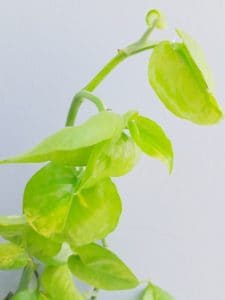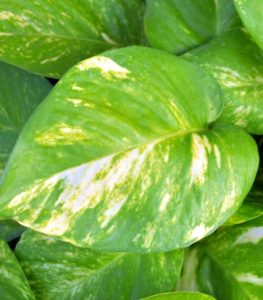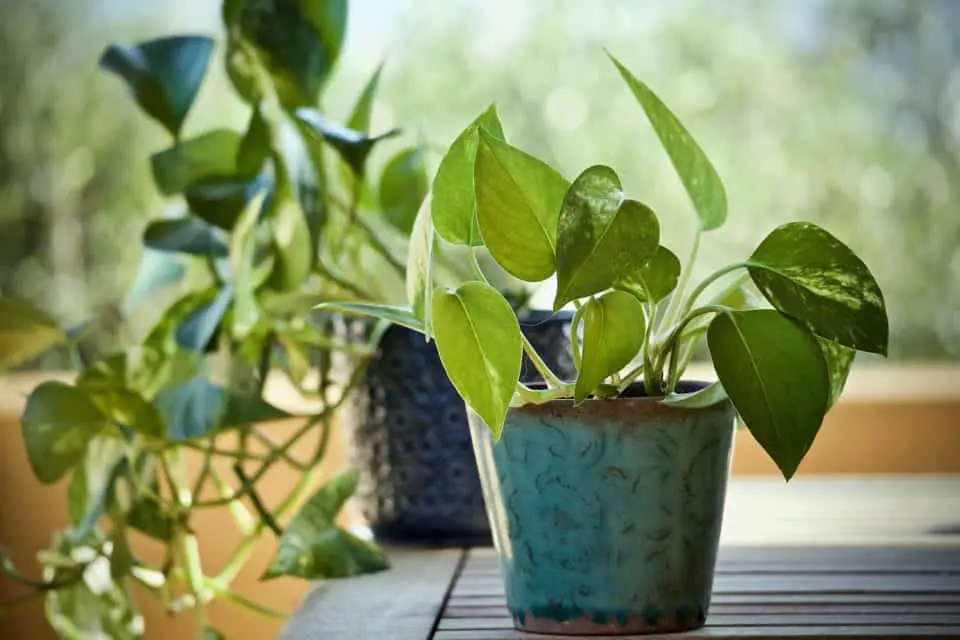Some links in the post are affiliate links and I get a commission from purchases made through some links found in the post.
Pothos plant is one of the commonest and easiest household plants to grow.
It requires minimalistic care and basic growing techniques, making this attractive plant an easy way to add some green to your house.
Its botanical name is Epipremnum aureum and is commonly known as money plant, devil’s ivy, taro vine, silver vine, and Ceylon creeper.
It is a hardy indoor plant with splendid foliage that belongs to the arum family. Southeast Asia’s tropical areas and the islands of the Western Pacific are home to this species.
It is often cultivated as a hanging plant in homes and climbs via aerial roots. It can achieve an incredible height by growing along with the towering trees.
This property makes it an excellent choice for your outdoor spaces. Let the vine shape run across the table, mantelpiece, or bookshelf to create a soft dwelling touch.
Because they can endure low light, Pothos plants are a fantastic addition to your kitchens and offices.
 You can also place them on shelves in your bathrooms where the increased mugginess will help them to flourish efficiently.
You can also place them on shelves in your bathrooms where the increased mugginess will help them to flourish efficiently.
Most importantly, Pothos is one of the best houseplants for improving indoor air quality and cleaning up your home or workplace.
They have thick, shiny, textured, heart-shaped green leaves with yellow hues. The little, white, hooded blooms that appear on mature plants in their natural environment are inconspicuous.
This plant can be grown in both dry soil and water. They require bright indirect sunlight and high-quality well-drained soil to grow.
Direct sunlight can cause discoloring and burning of leaves. Their growing pace depends on their different varieties.
They are mildly poisonous. When ingested, they can cause vomiting. They can be easily propagated by stem cuttings and through division.
Why Does your Pothos Have Brown Stems?
Having brown stems on a pothos is usually a sign of a decaying plant. Various reasons can cause the browning of stems. A few of them are listed below:
- Inappropriate watering including both under-watering and overwatering.
- Too much exposure to direct sunlight
- Use of excessive fertilizers
- Temperature and soil problems
- Fungal and bacterial infections
1) Watering Problems
Watering is a crucial part of gardening. Improper watering can cause early plant death.
When the water in the soil below the plant exceeds the plant’s own needs, the additional water prevents the roots from receiving oxygen.
This leads to root decay. As a result of root decay, the plant will not be able to get the essential minerals and nutrients required for its growth. This in turn will cause the browning of stems.
If you need help watering your plant, try using this automatic drip irrigation kit.
2) Too Much Exposure to Sunlight
Pothos tolerates a broad range of light conditions but does not thrive in direct sunshine. It requires bright indirect light to thrive.
Direct sunlight can cause your pothos to have dark brown stems. They can tolerate low light as well. But if your Pothos plant is highly variegated, especially white variegated, it may lose its variegation.
If your plant is struggling due to light, trying using this to help regulate the lighting.
3) Use of Excessive Fertilizers
Excessive use of fertilizers leads to the deposition of excessive nutrient salts in the soil.
This in turn harms the roots causing them to decay and rot. This ultimately causes the browning of stems.
4) Temperature
Pothos should be placed at a temperature above 50 degrees Fahrenheit, with an optimal range of 60 to 80 degrees Fahrenheit.
Pothos loves high humidity, which is comparable to its natural environment, although it can also tolerate ordinary or dry air.
But extreme temperature conditions can lead to the browning of stems.
5) Soil
Pothos loves to flourish in well-drained soil. If the soil is improperly drained, this can be one of the reasons behind the browning of stems.
It favors a slightly acidic pH of 6.1 to 6.5 but may tolerate slightly higher or lower levels.
If you’re enjoying this article, check out our article on why do pothos leaves drip water and how to make a pothos climb.
How to Save Your Pothos From Having Brown Stems
To save the brown stems on your pothos plant you need to take into account the following: The water routine, not being in direct sunlight, the soil, fertilizer and temperature.
Fixing the Watering Routine
Allow the soil to dry before watering again to avoid overwatering. Allow the above two inches of the soil to dry so that the roots remain wet.
When the leaves begin to wilt and droop, this indicates the time to water the plant.
Again if you need help watering your plant, try using this automatic drip irrigation kit.
Your Pothos Plant not in Direct Sunlight
Place them in spots that receive indirect bright sunshine. If your pothos plant is growing next to a window, you can use a thin window curtain to avoid direct sunlight.
Again if your plant is struggling due to light, trying using this to help regulate the lighting.
Repot the Plant
One of the ways to save your pothos is to repot the plant. Examine the soil carefully. If it is too wet, replace it with dry soil.
Avoid Excessive Use of Fertilizers
Pothos is a light breeder. Use a balanced fertilizer every three months to keep it in perfect form. You can remove excessive salts in your soil by running water through the soil.
Maintain Temperature
Keep your plant in a room with a suitable temperature range.
How Does Your Pothos have Brown Tips?
 Your pothos has brown tips due to the following reasons
Your pothos has brown tips due to the following reasons
- Many plant diseases can cause brown spots on leaves. One of them is a common bacterial disease caused by Pseudomonas cichorii.
- Brown tips may be due to improper environmental conditions such as high humidity, extreme direct sunlight, and poor air circulation.
- Overwatering can cause the tips and edges of the leaves to decay and turn brown.
- Damp soil causes roots to rot which leads to brown tips.
- Manganese toxicity can also cause the browning of tips and edges.
- Brown edges and tips can be a sign of under-watering.
- Cold temperature can cause discolored leaves with brown tips.
- Similarly, different pests such as mealybugs and scale can harm.
- Pest infestations and fungal diseases can also cause the tips to turn brown.
- Improper fertilizer application, too much or too little, can burn out your leaves.
- When deciding to water your plant, tap water must be avoided if your leaves start to turn brown at their tips.
If you are enjoying this article, check out our article on the hawaiian pothos vs the golden pothos.
Why are Your Pothos Plant Stems Splitting?
Stem splitting indicates that your Pothos may be in trouble. Your pothos plant stems splitting can due to several reasons which are briefly mentioned below
- Reassure the perfect environmental conditions for plant growth. Stressful and extreme environmental conditions may cause stem splitting
- Direct sunlight is a determining factor in the maintenance of this plant. It appears to cause a major share of plant stem splitting.
- Sometimes low humidity can cause the splitting. Keep an eye on your plant and check it regularly to ensure that it’s getting adequate water.
- Overwatering is a threat to this plant. It is the most common cause of root rot that leads to stem splitting in a stepwise fashion.
- Examine the soil’s water content and the room’s temperature to determine which is more likely to be the source of problems.
- Under-watering is also a concern when saving a pathos plant. When the plant does not receive enough moisture, it suddenly leads to the splitting of the plant.
How to Save Your Pothos Plant?
There are a few ways to save your Pothos plant which are shared below
Proper Light
Pothos need consistent, indirect sunshine. Direct sunshine will scorch your plant, while insufficient light will cause it to use more energy than it consumes.
Adequate Watering
Water your Pothos regularly with clean water in a perfect amount. Always try to avoid overwatering that is the leading cause of browning of leaves. We have an article to help you out on how to save an overwatered pothos.
Maintain Warm Temperature
Keep your temperature range between 70-degree F and 90-degree F. Higher temperatures than this must be avoided.
Proper Drainage
This is one of the most important factors to consider while growing Pothos as they are highly susceptible to overwatering.
The bottom of the pot should have enough drainage, and you should choose soil that isn’t too compacted to allow the water to drain.
Look for Any Pest Infestation
Regularly check your plant for any kind of infestation. If you suspect any bacterial, fungal, or any other disease, take necessary actions immediately.
Keep your Pot Clean
Look for any brown leaves and stem splits. Remove the decaying and wilting leaves and keep your pot clean as this will help the plant to remain pest-free.
Pruning
Plants can be pruned to a tighter shape or left to spread. To stimulate new branch sprouting, trim bare stems back to the soil level.
Any diseased part must be trimmed alongside so that it does not invade the neighboring stems.
You may also like: Pothos vs Philodendron
Final Thoughts
 Pothos plant is a low-maintenance beauty with big heart-shaped leaves. It adds vibrant colors to your indoors as well as outdoor spaces.
Pothos plant is a low-maintenance beauty with big heart-shaped leaves. It adds vibrant colors to your indoors as well as outdoor spaces.
Despite the lack of blossoms, this vine, which is comparable to philodendron, has a broad range of leaf colors and patterns to suit a variety of preferences and decors.
Pothos are usually pest-free plants which makes them a suitable option for gloomy spaces and your boring workplaces.
You’ll be well on your way to a long and happy relationship with your Pothos plant if you provide it with a well-lit room, appropriate temperature, excellent drainage, proper watering, regular cleaning, and regular checkups.
Trim it regularly and remove the leaves that turn brown. This will increase the health status of your plant. Always avoid the use of excessive fertilizers that can cause the roots to decay.
About the Author:
Saad Ansar
Saad is an avid gardener himself and is a great lover of plants, animals, photography, & people. Currently, he is focused on photographing indoor plants & captioning beautiful outdoor sceneries. He writes and rewrites in-depth articles on nature and science.


